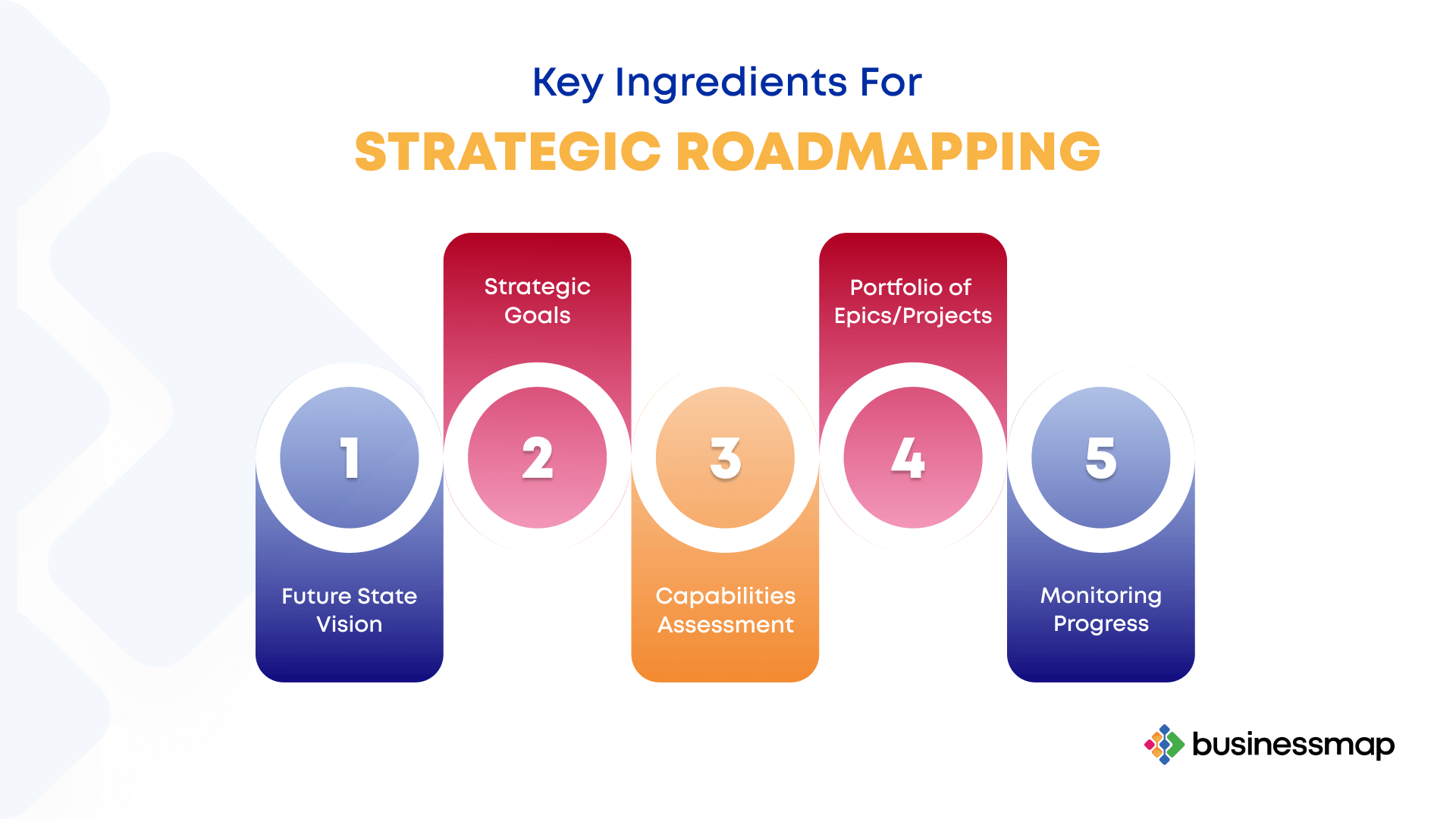What Is a Strategic Roadmap?
A strategic roadmap is a comprehensive guide outlining the vision, goals, and critical initiatives or projects of an organization over a defined period. It is a dynamic planning tool that aligns stakeholders, activities, and resources to achieve strategic objectives. At its core, a strategic roadmap provides clarity on the path forward, laying out key milestones, timelines, and dependencies. Integrating strategic priorities with actionable plans empowers teams to prioritize initiatives, allocate resources effectively, and track progress toward overarching goals.
In short, a strategy roadmap presents a rough map of a company's current and desired state. It provides a well-structured and aligned framework highlighting key actions for short-term and long-term accomplishments.
Understanding the Role of a Strategic Roadmap
The role of a strategic roadmap in the entire strategy-to-execution process is vital for a number of reasons. First, it serves as a guiding map that helps organizations on their journey toward reaching their high-level goals. Furthermore, it helps navigate the complexity of the work and align efforts across different business units and teams. Using strategic roadmaps allows managers to visualize the most critical objectives and generate actionable proposals that stay true to the business goals.
Is Strategic Roadmap a Plan?
Some of you may be wondering if there is a difference between a strategic roadmap and a plan. The truth is that they differ even in a slight way. Let's uncover how to tell them apart.
The main difference between a roadmap and a plan comes from the message each tool delivers.
When talking about plans, the purpose is to describe how a company will deliver the objectives that contribute to a company's strategic vision achievement. They incorporate information about the business mission and goals, actionable plans, teams in charge, and lay out a deadline.
Rather than focusing on how, strategic roadmaps detail the strategic reasoning – the why and what. What are the main objectives the company needs to execute, and why are they important? Roadmaps illustrate the business scope and provide a high-level overview of the strategy and focus areas.
To summarize, plans are built upon strategic goals and describe the directions on how to implement them. In contrast, strategic roadmaps provide a visual representation of what needs to be delivered to achieve the strategy in place. Even though most roadmaps contain a timeline, it only roughly portrays when key outcomes should be completed by because changes are likely to occur.
Primary Ingredients for an Effective Strategic Roadmapping
Building a strategic roadmap that shapes meaningful changes for a company requires thoughtful planning and consideration. When creating your roadmap, keep the following essential aspects in place:
 Strategic roadmap key aspects
Strategic roadmap key aspects
Understand the Current Position of Your Business
Performing a situation analysis informs you about the current position of your company. This process involves conducting a company review and competitor research using business tools such as SWOT and PEST analysis. This gives you a deeper understanding of your company's priorities and what changes need to be made in areas you wish to accelerate. On top of that, it helps you identify where your efforts and resources should be directed to utilize them in the most productive way.
It is essential to go through this step as it sets the ground base for defining your future state vision and organizational strategy.
Lay Out Strategic Objectives
A strategic roadmap is incomplete without setting the essential high-level goals you want to reach. Derived from your company's vision and strategy, these objectives address the challenges you want to overcome and seize potential growth opportunities. A practical tip is to use goal-setting frameworks such as OKRs to precisely visualize what your main priorities are and what you're going to use to measure whether you're achieving them.
Components such as the company size, structure, and nature of business determine the scope of the organization's primary goals. Usually, strategic objectives are set at the company level, which can be further broken down into goals across departments and teams. When talking about larger enterprises, however, there could be multiple strategic objectives for different business areas/lines within the organization. In this case, it'd be better to have a dedicated strategic roadmap for the specific area of the business.
Evaluate Capabilities through Value Stream Mapping
It is crucial for the success of your strategic management to properly assess your current capabilities, including staff, technologies, processes, time, finance, etc. These are the resources that drive your organization's operations, and it is advisable to address them carefully. This gives you an in-depth insight into whether their capacity is enough to meet your objectives or the need to adjust your initial plan.
An effective technique that Agile organizations use is implementing value stream mapping. The primary purpose of this Lean management tool is to visually present how your business brings value to the end customers. This happens by displaying and analyzing each business line's most vital process steps and activities. Doing this can help you better understand the flow of value to identify risks and determine your delivery capabilities.
Determine Execution Initiatives
When you have your capabilities assessed, it is time to translate objectives into execution activities on a management level. Depending on the level of granularity, these action items could be programs or portfolios of projects. A good practice is to use techniques to prioritize portfolios and initiatives that are of the highest importance for the business and start with them first.
Define and Track KPIs
It is hard to tell whether you are close to achieving your goals or not unless you have established specific benchmark targets. Setting critical KPIs matched to your long-term goals informs about the progress of completion. Tracking them allows for a quick reaction to unexpected circumstances and adjusts the course of action accordingly.
Visualize Your Roadmap
Once you get familiar with what your organization strives to accomplish in the long term, you can structure your roadmap and put it on display to be available for everyone involved.
Considering the abovementioned primary components, you can take the image below as an example of a well-structured and goal-oriented strategic roadmap. In a nutshell, your roadmap should consist of your business's main objectives or goals (future target state), several key metrics that set the primary business targets, and a brief set of different high-level company unit initiatives you plan to work on.
 Strategic Roadmap Visualization. Image Credit: Business Documents
Strategic Roadmap Visualization. Image Credit: Business Documents
Keep in mind that the strategic roadmap is never "set in stone". Instead, think of it as a living, breathing organism that changes based on the dynamics of the market and your organizational strategy.
We offer the most flexible software platform
for outcome-driven enterprise agility.
In Summary
A strategic roadmap is an invaluable tool that makes a strategic vision a reality. It helps companies avoid losing sight of their long-term goals by putting them on display along with their correlated execution initiatives. It visualizes the transition from a company’s current state to the target state.
Think about the following key aspects when building a strategic roadmap:
- Analyze your company’s current environment before setting the strategic vision.
- Nominate your strategic long-term goals.
- Assess your capabilities and optimize resource allocation.
- Build your initiatives.
- Set and track essential KPIs.
- Visualize your strategic roadmap.





 Strategic roadmap key aspects
Strategic roadmap key aspects Strategic Roadmap Visualization. Image Credit:
Strategic Roadmap Visualization. Image Credit: 


